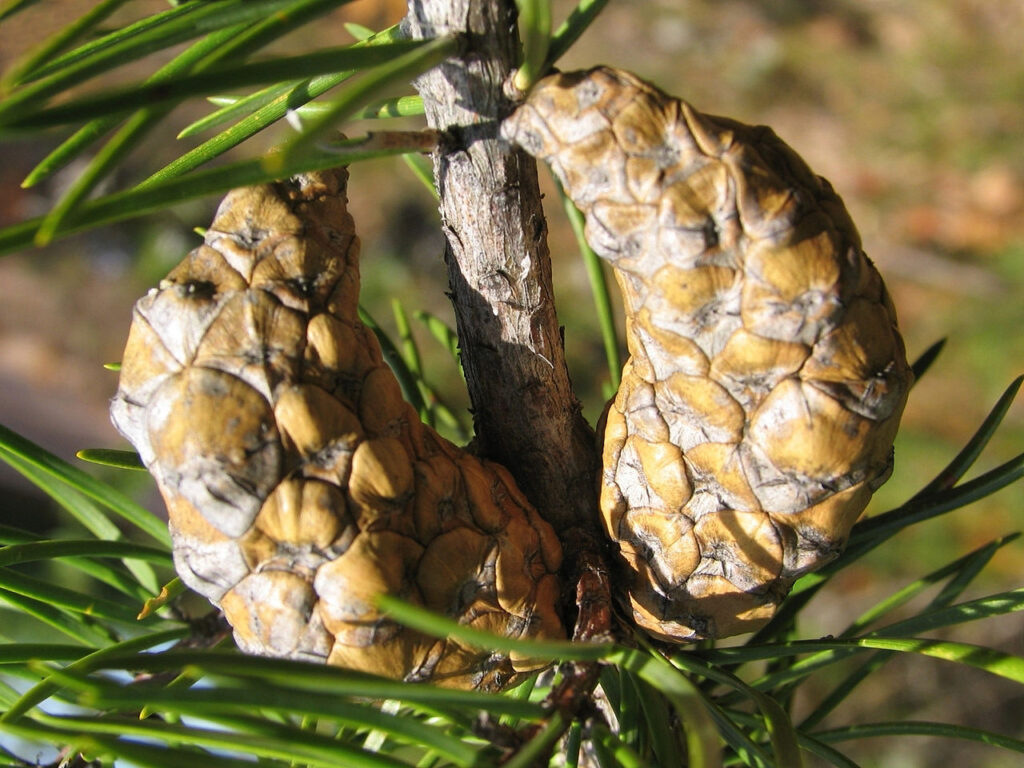
While maple irrefutably holds the top spot as the most iconic tree species in Canada, the jack pine is a close second in terms of cultural significance. This widespread pine tree has long been recognized as a symbol of the Canadian wilderness, and its essence has been captured in prominent Canadian art and literature.
Look no further than the iconic Group of Seven paintings to spot a jack pine as a focal point. Or read the works of Canadian authors and poets for references to this native tree’s rugged beauty, resilience, and tenacity. Better yet, take a walk in nature and see if you can spot a stand of jack pines growing in your community!
Learn more about this interesting tree species below!
About Jack Pine Trees

The jack pine tree (Pinus banksiana) is a native boreal conifer that is recognizable by its scraggly appearance and ability to grow in conditions where other tree species struggle. While it is not picky about soil – often thriving in nutrient-poor, sandy, and rocky sites – jack pines do require full sun in order to thrive.
Jack pine trees are a “pioneer species”, meaning they are one of the first trees to re-established themselves in disturbed or open areas following logging and mining. They are also “fire-adapted”, which means they regenerate quickly after a forest fire or controlled burn.
Interestingly, jack pine cones require heat or fire to open, making them an important species for forest restoration in fire-prone areas.
How to Identify Jack Pine Trees

Jack pine trees can be identified by their size, shape, bark, needles, and cones. Since jack pines are the most widespread pine species in Canada, you will likely have luck finding them somewhere in your region!
Size: Medium size at maturity, reaching average heights of 40-70 feet.
Shape: Somewhat pyramidical, scraggly and irregular. Lower branches often die due to lack of sun but remain on the tree.
Bark: Thin, scaly, and reddish-brown when young, though may become grey and furrowed as the tree ages.
Needles: 3/4-1.5 inches long with pointed tips, growing two per fascicle.
Cones: 1.5-2 inches long with a woody appearance and a noticeably twisted or curled tip when mature. Young cones are green. When closed, cone scales on both mature and young cones are held tightly together by resin.
Wildlife Value of Jack Pine Trees

As jack pine trees are some of the first trees to re-establish themselves after destruction or disturbance, they play an important role in supporting biodiversity in forest ecosystems.
Many birds, particularly those that live in burned areas, rely on the jack pine for nesting and foraging. Red squirrels, snowshoe hares, chipmunks, and insects also use these trees for shelter and food sources. Deer and moose will consume jack pine too, preferring to eat needles that are within their reach.
In addition to having excellent wildlife value, jack pine trees can help reduce some pressure on commonly overharvested tree species, making them an important part of forest preservation!
Harvesting Seeds From Jack Pine Trees
Since jack pine trees require exposure to heat or fire to open their cones, you will likely find many mature cones clinging to the branches of this species. Jack pine cones will sometimes open at maturity, though they are known to hang onto their closed cones for up to ten years while waiting for their preferred seed-dropping conditions.
To harvest jack pine seeds, select cones that are tightly closed and brown in colour. Place the cones in a paper bag in a warm, dry spot indoors. After a few days, separate the scales and remove the seeds.
As jack pine seeds lose their viability quickly, be sure to plant them in a nursery bed with well-draining soil shortly after harvesting. If you cannot plant them right away, store the seeds in a cool, dry place.
Remember that this tree species requires open spaces with full sun where it can spread its scraggly branches and show off its unique character. Plan to add the jack pine to your property for some interesting visual appeal. Or consider establishing a stand in clear-cut or disturbed areas to support reforestation and reduce pressure on other tree species in the future. Whether you plant one jack pine or several, you’ll love watching these iconic trees flourish. The native wildlife will thank you for planting some in your community too!
Learn More About Trees and Forest Restoration
Want to learn more about how you can participate in forest restoration at home? Take a look at our collection of Forest Restoration Nurseries resources and our free Community Nurseries guide brought to you by the Knowlesville Art and Nature Centre and The Tree Project!
Stay in touch with us by following the Knowlesville Art and Nature Centre on Facebook and Instagram!
